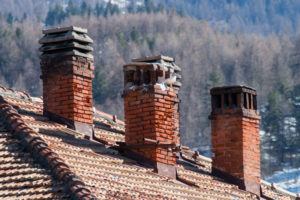Is your chimney ready for the fall? There are several common chimney problems that could delay your enjoyment of your fireplace this fall. Fortunately, if you are on the lookout for these common chimney problems, you can have them addressed before you are ready to light your first fire.
Cracked masonry 
Chimney masonry bears the brunt of bad weather. It must handle rain, snow, sleet; heavy winds; and freezing temperatures. The masonry inside
your fireplace endures the extreme temperatures of your fire. Those harsh conditions take a toll on your fireplace and chimney masonry over time and can cause damage. If masonry damage goes unchecked, it can threaten the structure of your chimney and even pose a fire risk. If you notice cracked or crumbling in your chimney or firebox masonry, you are due for some repairs.
Chimney leaks
Nothing can devastate a chimney like a water leak. A leaking chimney can cause damage to your entire chimney system and even to your home’s structure. Be on the lookout for water or moisture pooling within your fireplace, rusting on your damper, fire grate or fireplace doors, and for warping or discolored ceiling and walls. On the outside of your chimney, white, black, green or rust-colored stains also can indicate a chimney leak. Because of its propensity for causing costly damage, signs of a chimney leak should not be ignored.
Deteriorating chimney lining
Chimney liners are built to last, but they can break down over time. A cracked or crumbling chimney liner can allow the smoke and heat from your fire to infiltrate your home’s structure. If your chimney liner is failing, you might notice chunks or flakes of tile in the bottom of your firebox.
Bad draft
A bad chimney draft can render your fireplace unusable, as it allows your home to become filled with smoke each time you light a fire. If you notice smoke invading your home when you light a fire, contact a chimney sweep to inspect your draft and make recommendations for improving your chimney draft.
Missing chimney cap
A chimney cap is your chimney’s best defense against water damage, and a missing or displaced chimney cap can allow water to pour down the walls of your chimney. If you don’t see a chimney cap covering your chimney, if your chimney cap is sitting askew or if water pours down your chimney each time it rains, you should have your chimney cap replaced.
Failing damper
A failing chimney damper is like an open window in your home. When the temperature drops, hot air will escape up your chimney, and your home will be filled with a cold draft. Check your chimney damper to see if it is opening and closing properly. If you can’t determine if your damper is sealing completely, there is one quick test you can perform: With the damper closed, light a match or small roll of newspaper in your firebox. If the smoke goes up your chimney, your damper isn’t sealing.
If you notice signs of any of these common chimney problems, call Environmental Chimney Service to schedule an appointment today. We’ll fix your problem and have your chimney ready for fall!
